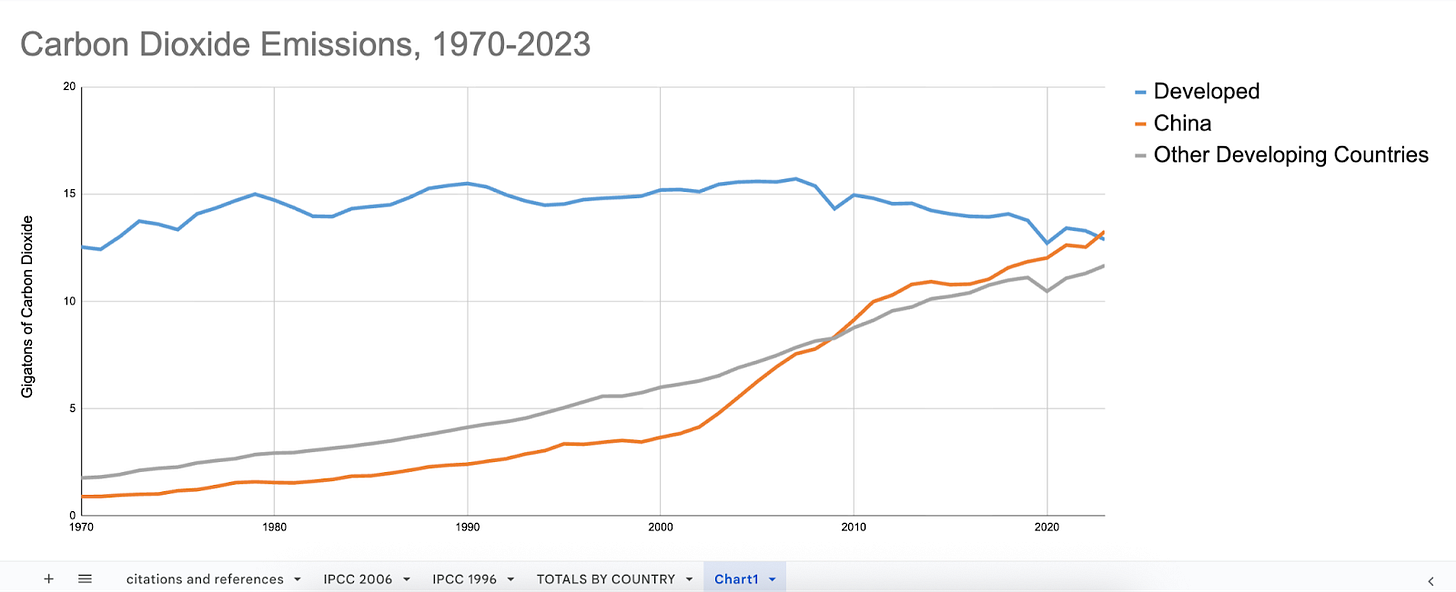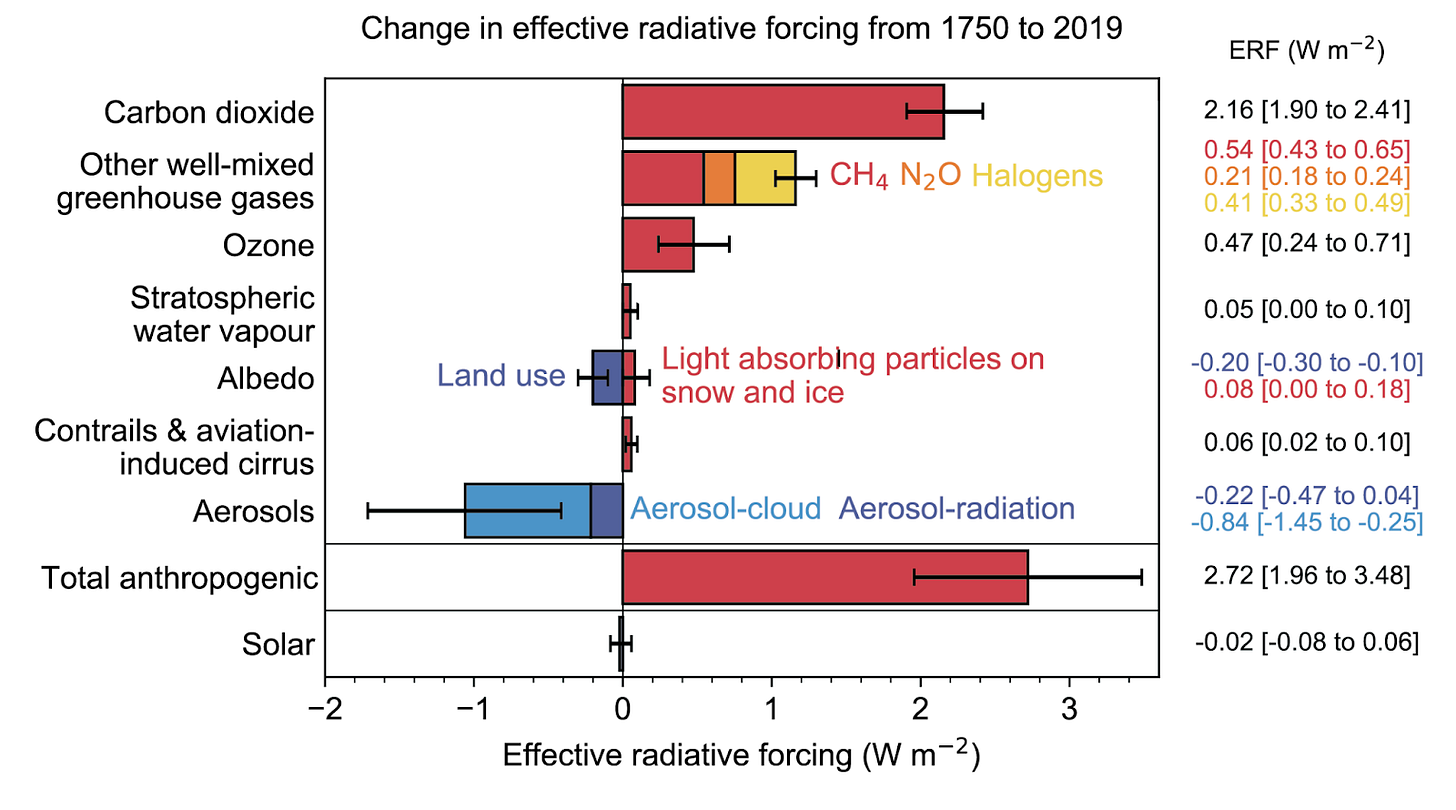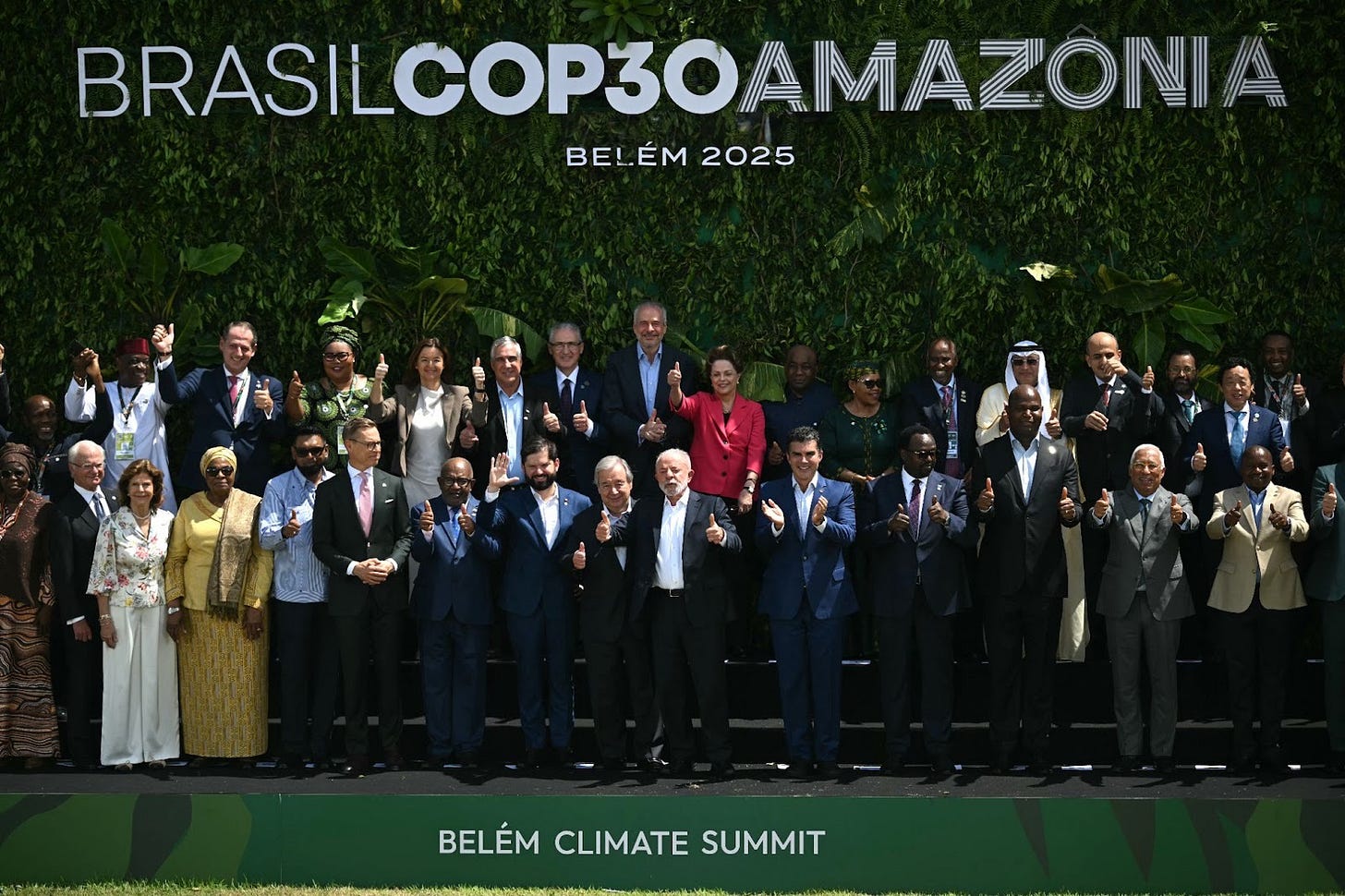COP Can’t Cope With Climate Risks
We need a climate moonshot. That sure as hell won’t come from the UN.
It’s that time of year again: climate negotiators from around the world are converging on an exotic locale—this time it’s Belém, in the Brazilian Amazon—to negotiate an intricate global agreement that won’t really change the planet’s climate trajectory.
The yearly Conference of Parties to the United Nations Framework Convention on Climate Change—COP, to habitués—has morphed, over the years, into a kind of travelling circus grotesquely mismatched to the problem it’s meant to address.
There’s a soul-deadening regularity to the proceedings. Tens of thousands of politicians, negotiators, activists, NGO-types, journalists, and hangers-on of every description declare themselves shocked that global carbon emissions are even higher now than they were when they met a year earlier. Looking solemn, they make heartfelt pledges to do better, to really change this time. A year later, they do it all again.
Having gone through this rigamarole thirty times now, you’d think the world would have caught on that the COP process doesn’t work, and doing it harder won’t help.
But why doesn’t it work? Because it’s built on the wrong model of what determines a country’s level of greenhouse gas emissions. COP imagines these emissions as something a country’s government can set, like the dial on a thermostat. But emissions are more like GDP: the outcome of a complex process that politicians would like to be able to control, but don’t actually control.
Like GDP, climate emissions are the cumulative result of billions of decisions made by billions of actors—climate negotiators, utilities companies, grid operators, regulators, politicians, bureaucrats, bankers, investors, companies, and households—each of whom has to weigh a range of tradeoffs. Those include air quality and carbon emissions, yes, but also affordability, reliability, sovereignty, natural resource endowments, and technological readiness.
In developed countries, the combined outcome of these decisions has been slowly-falling emissions over the last couple of decades. Since their high water mark in 2007, developed country CO2 emissions have fallen from 15.7 gigatons to 12.9 gigatons in 2023. (A gigaton is a billion tons.)
Also in 2023, for the first time, China emitted more carbon dioxide than all of the developed countries put together. Between 1970 and 2023, Chinese emissions grew from 7.6 gigatons a year to 13.3 gigatons a year, and emissions from the rest of the developing world rose from 7.9 to 11.7 gigatons. For each molecule of CO2 emissions rich countries have cut since 2007, developing countries have added three.

The reasons are sort of obvious. Across the developing world, people who care about the climate are a small minority, and concern over greenhouse gas emissions isn’t very salient. Policymakers are under intense pressure to deliver cheap, reliable energy, and when they weigh their options, they still tend to find coal or oil is the way to deliver that.
Low-carbon energy sources—whether solar, wind, nuclear, or geothermal—face significant obstacles to quick adoption: batteries that remain much too expensive at grid scale and require dauntingly sophisticated grids, high capital costs for nuclear and hydroelectric power, and not enough trained STEM graduates to operate any of these high-tech options.
And so since 2020 new coal-fired power plants have been approved or built in China, India, Indonesia, Bangladesh, Zimbabwe, Vietnam, Laos, Russia, Kazakhstan, Turkey, South Africa, Pakistan, the Philippines, Kyrgyzstan and Mongolia. In 2023, three gigawatts of new coal-fired generation were introduced for every gigawatt retired. Upstream investment in new oil and gas facilities is still above half a trillion dollars a year, and expected to keep rising all through this decade.
Yes, renewable energy is growing faster still, but at this stage it’s growing alongside a still-expanding fossil fuel industry, not replacing it. And while many studies project emissions to peak in the next decade or so and then to start falling, the downward slope they’re expected to follow after they peak is too shallow for comfort.
Nothing that happens in Belém this week will change any of that. Trying to shift this reality with a UN conference is like trying to loosen a rusty bolt with a wet noodle: just the wrong tool for the job.
On the day in 1765 when James Watt invented a much more efficient steam engine, Earth’s atmosphere held around 2,170 gigatons of carbon dioxide. (It’s a good thing, too: without all that CO2, Earth would’ve been frozen, like Mars.) Since the 18th century, human beings have added a cumulative 1,180 gigatons of CO2 to the air, bringing the total stock of atmospheric CO2 to about 3,350 gigatons.
We continue to add the equivalent of 40 gigatons each year. About 18 of them are absorbed by carbon sinks on land and in the ocean. So the stock of atmospheric carbon dioxide grows by about 22 billion tons with each passing year.
What that means for the climate is a lot less straightforward than people realize.
“Climate sensitivity”—how much additional atmospheric carbon dioxide corresponds to how much additional warming—is a famously tough nut to crack. Big knowledge gaps remain. Changes in land use, in dust in the air, in ozone, in snow and cloud cover, in pollution from maritime shipping, and in sulphur pollution from industry, all have an impact on how much additional heat the atmosphere traps. In particular with regard to aerosols and clouds, the error bars remain strikingly wide:

The upshot is that we don’t know exactly how much more greenhouse gas will map onto how much additional warming by 2100, over and above the 1750 level.
But if you ask the scientists who write the UN’s Climate Assessment reports, their guesses are pretty grim. The median estimate among them is 2.7 degrees celsius, with 86% estimating warming above 2 degrees. Fifty-eight percent of scientists polled think a three-degree-hotter world is a 50-50 scenario.
Is that a lot or a little? That, again, is not so straightforward.
In some ways, it’s far too much: it shows we’re far off track from the 2015 Paris Agreement goal of holding warming well below two degrees celsius. In other ways, it’s not so bad: just a few years ago, mainstream scientists warned we might be heading for 4, 5 or even 6 degrees of warming by 2100. Those extreme scenarios no longer appear plausible.
Of course, just because this 2.5 to 3 degree warming range is mainstream, that doesn’t make it right. Some prominent scientists think the IPCC consensus is badly underestimating climate sensitivity. Former NASA scientist James Hansen, perhaps the best-known climate scientist of them all, headed an 18-author team that argued powerfully that cloud and aerosol impacts mean we’re in for substantially more warming than IPCC models suggest. Their landmark 2023 paper “Global warming in the pipeline” argues that aerosol and cloud effects will come in towards the worse side of the error bars, leading to substantially faster warming. This is not the majority view, but the people who hold it are far from cranks.
So climate sensitivity is a big source of uncertainty. And it’s not the only one.
Even if we could agree that we’re heading for a three-degree-hotter world, that would still leave us with only the haziest idea about what exactly that means for people. As the old climatological cliché puts it, “nobody lives at the global mean”—what actually matters is how a more energetic atmosphere interacts with the conditions people actually encounter. What does it mean for floods? For droughts? For extreme temperatures? For sea level rise? For storms?
Science struggles with these questions. Run the same three-degrees-hotter simulation ten thousand times and you’ll get ten thousand different futures—some quite tolerable, many quite bad, a few truly horrible. Tweak your parameters even slightly and the outcomes shift again.
A three-degree-hotter world may do away with summer Arctic sea ice altogether, which models suggest would destabilize rain patterns across the Northern hemisphere leading to far more frequent extreme temperatures, both hot and cold. Or it might not. It might cause a collapse in agricultural productivity across the Sahel. Or it might not. It might send the warm ocean currents that keep Europe livable in winter into irreversible decline. Or it might not.
When it comes to the really dire tipping points, we’re almost as ignorant. A three-degree-hotter world by 2100 isn’t expected to cause Siberia’s permafrost to thaw quickly enough to unleash a burst of methane that massively speeds up global warming. But we can’t rule that out. It probably won’t send the West Antarctic ice sheet into a death spiral that raises sea levels by up to ten meters over the next several centuries. But it might.
Bill Gates says climate change will not lead to humanity’s demise. He’s right, probably. Most model runs show a three-degree-hotter world where most places face manageable problems. But tail risks hang over this entire way of thinking like a sword of Damocles. Because each time you run the model, you get a different answer.
And in the real world, we only get to run the experiment once.
To a much greater extent than is usually acknowledged, then, we’re flying blind. “Deep uncertainty” is the applicable jargon: the maddening disconnect between what science can tell us and what we need to know.
What people want to know is what they can expect in the places where they live. All science can offer is a probability function pointing to greater or lesser degrees of risk. Policymakers want to know how much bang they can expect for tax-payers’ climate buck. All science can offer is a directional shrug.
What we do know is that every ton of greenhouse gas we add to the atmosphere nudges that probability function further toward worse outcomes—and globally, we’re still emitting more and more each year. We can’t really say how likely this or that catastrophe is, but we can say that the more we emit, the scarier the risks.
Which is why atmospheric scientists virtually all get a desperate knot in their throat when they look at the trajectory we’re on: not because they know we’re doomed, but because we might be doomed, and the longer we take to decarbonize, the worse our odds get.
Beyond the partisan shouting matches, beyond the catastrophism and the denialism on the left and the right, we’re running a vast, uncontrolled experiment in atmospheric chemistry with results we can only guess at. Our global effort to curb the threat—the UN Framework Convention on Climate Change—plainly doesn’t work, but because they’ve sunk so much cost into it, world leaders refuse to acknowledge that failure.
While COPworld wallows in denial, a small but influential group of climate thinkers is taking a hard look at the real options we have. Thinking outside the COP box, they’re urging a conversation from first principles about what we can really do in a world where risk is so hard to pin down.
One intriguing prospect involves shielding the Earth from some of the sun’s energy by dispersing reflective particles in the stratosphere. As a matter of science, it would probably work, at least as a stop-gap to buy time while we figure out how to really decarbonize.
Personally, I am ambivalent: the problem isn’t so much the thermodynamics as the geopolitics. The battered and bruised UN process soon to fail once more at Belém is in no condition to usher in a brave new world of geoengineering. And if any one country were to go it alone, it could destabilize international relations with unpredictable consequences. At the very least, the world’s biggest powers (China, the United States, Russia, the European Union, India, and Brazil, say) would need to reach some kind of agreement to support Solar Radiation Management. I don’t see those players agreeing on anything, much less something as ambitious as this.
We should cast our technological net wider, exploring a range of promising ideas to mitigate climate outcomes. Stabilizing Arctic ice needs to be a priority: models tend to show the weather going haywire when summer sea ice disappears. Engineering plans to protect the West Antarctic ice sheet from collapse can sound “out there,” but when you grasp the potential consequences of inaction, what’s really “out there” is doing nothing. Brightening marine clouds can protect some of our most sensitive ecosystems. And much more research is needed to bring next generation nuclear reactors into mass production.
What would make the biggest difference, though, is a Manhattan Project-style push to develop technologies to remove carbon dioxide from the atmosphere at gigatons’ scale. Stimulating ocean photosynthesis by helping carbon dioxide-trapping marine microorganisms to thrive is, I think, our best shot at a scalable, low cost, ecologically sound way to get there. That’s why I spend most of my time working on phytoplankton carbon: it is the highest-impact, lowest-risk moonshot on the horizon.
There are others we should be looking into, but aren’t. The climate Overton Window has stayed tightly constrained around a set of decarbonization outcomes that made sense in the 1990s, but which make no sense given the situation we face now. Technologists determined to explore ambitious solutions from first principles have been frozen out of the climate debate.
If you care about the climate, forget about COP. Support them.
Quico Toro is a contributing editor at Persuasion, the founder of Caracas Chronicles, Director of Climate Repair at the Anthropocene Institute, and writes the Substack One Percent Brighter.
Follow Persuasion on Twitter, LinkedIn, and YouTube to keep up with our latest articles, podcasts, and events, as well as updates from excellent writers across our network.
And, to receive pieces like this in your inbox and support our work, subscribe below:





In a few centuries we will likely have fewer than one billion people on the planet. I am sure they can adapt. The planet will live on happily.
"Beyond the partisan shouting matches, beyond the catastrophism and the denialism on the left and the right, we’re running a vast, uncontrolled experiment in atmospheric chemistry with results we can only guess at."
We're not running an experiment. We are actually giving people massive improvements in their lives in developing countries. Our energy production systems are the single most important factor that enables us to live better than our ancestors four hundred years ago. THAT is the thing against which we need to compare the costs of climate change.
I also feel like there is still trapped in this a sort of catastrophism. I think prudence is indicated, given the possible bad outcomes, but without knowing HOW things will take shape and where, and where the lines even are, it's impossible to know how much of our power should be devoted to which parts of the risk. The only thing we are fairly certain is likely to reduce the risks is reducing the carbon, which is presumably why that's where the focus is, but we can definitely put ourselves in a position where over-investing now will make us less agile in the future when we have a much clearer picture of the risks and costs.